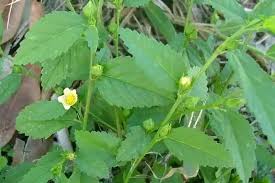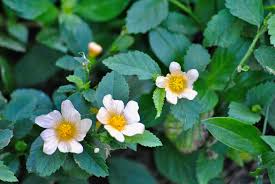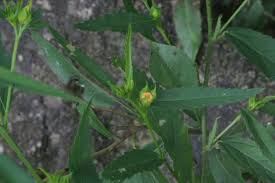How Sida acuta is used in herbal medicine reflects its extensive application across various cultures for promoting health and treating ailments. This perennial herb, commonly known as “wireweed” or “broadleaf sida,” is recognized for its diverse therapeutic properties, which have been valued for centuries.
Native to tropical and subtropical regions, including Africa, Asia, and the Americas, Sida acuta has a long history in traditional medicine practices. Its leaves, stems, and roots are utilized to address a variety of health concerns, positioning it as a vital component of herbal healing traditions.
One of the primary applications of Sida acuta in herbal medicine is its anti-inflammatory effects. Traditional healers often employ the plant to relieve conditions marked by inflammation, such as arthritis and skin irritations.
The herb contains bioactive compounds, including flavonoids and tannins, which are known to reduce pain and swelling, offering an alternative to synthetic anti-inflammatory medications. As a natural remedy, Sida acuta appeals to those seeking holistic approaches to managing chronic pain and inflammation.
In addition to its anti-inflammatory properties, Sida acuta is celebrated for its antibacterial and antifungal activities. Traditionally, the herb has been used to treat infections affecting the skin and respiratory systems.
Its leaves and stems contain essential oils and other phytochemicals that exhibit significant antimicrobial properties. As a result, Sida acuta is often applied topically to minor wounds and cuts, aiding in the prevention of infections and promoting faster healing. Moreover, its use extends to gastrointestinal health, where it helps manage bacterial growth in the digestive tract, contributing to improved gut health.
Another area of interest in herbal medicine is Sida acuta’s potential antidiabetic effects. Some studies suggest that this herb may help regulate blood sugar levels, making it a valuable addition for individuals with diabetes or those at risk of developing the condition. By enhancing insulin sensitivity and reducing glucose absorption, Sida acuta serves as a complementary remedy alongside conventional diabetes management strategies.
Furthermore, Sida acuta is believed to support liver health and detoxification. Traditional medicine practitioners utilize the herb to promote liver function and protect against liver damage. The rich phytochemical composition of Sida acuta, including antioxidants, plays a crucial role in neutralizing harmful free radicals, thus safeguarding the liver from oxidative stress and damage.
The diuretic properties of Sida acuta are also noteworthy, as they promote increased urine production, aiding in the elimination of excess fluids and toxins from the body. This effect is particularly beneficial for individuals dealing with hypertension or fluid retention. By enhancing kidney function and promoting healthy urinary flow, Sida acuta contributes to overall wellness and balance in the body.
As interest in natural healing continues to grow, research into the pharmacological properties of Sida acuta is expanding, validating many of its traditional uses. With its promising potential in herbal medicine, Sida acuta stands out as a versatile and valuable plant.
It offers numerous benefits for individuals seeking natural alternatives to conventional treatments, reinforcing its significance in the realm of herbal healing. As more people explore the advantages of herbal remedies, Sida acuta is likely to gain further recognition for its contributions to health and well-being.
Traditional Uses of Sida Acuta in Healing
1. Herbal Medicine: Sida acuta has a long history of use in traditional medicine across various cultures. The leaves, stems, and roots are often used to prepare herbal infusions, decoctions, or poultices for therapeutic purposes.
2. Treatment of Infections: Traditionally, Sida acuta is believed to possess antimicrobial properties. It is commonly used to treat infections, particularly in the urinary tract and respiratory system. Herbal preparations are applied externally or taken internally to combat bacterial and fungal infections.
3. Anti-Inflammatory Remedies: The plant is used in traditional healing practices to reduce inflammation and alleviate pain. Sida acuta is often recommended for conditions such as arthritis, muscle aches, and joint pain.
4. Digestive Health: Sida acuta has been traditionally used to address gastrointestinal issues. It is believed to help relieve symptoms of dysentery, diarrhea, and stomach ulcers. Herbal teas made from the leaves are consumed to soothe the digestive tract.
5. Skin Conditions: In traditional medicine, Sida acuta is applied topically to treat skin irritations, rashes, and wounds. Its anti-inflammatory and antimicrobial properties make it beneficial for healing cuts and preventing infections.
6. Fever Reduction: Sida acuta is also used to help reduce fever. Infusions made from the leaves are consumed to promote sweating, which can help lower body temperature during illness.
7. Blood Sugar Management: Some traditional practices involve using Sida acuta for managing blood sugar levels. Herbal preparations are believed to have a positive effect on glycemic control.
Chemical Composition of Sida Acuta

1. Active Compounds: The chemical composition of Sida acuta includes a variety of bioactive compounds, which contribute to its medicinal properties. These compounds include flavonoids, alkaloids, tannins, and phenolic acids.
2. Flavonoids: Sida acuta is rich in flavonoids, which are known for their antioxidant properties. These compounds help neutralize free radicals in the body, reducing oxidative stress and inflammation.
3. Alkaloids: Alkaloids present in Sida acuta may have various pharmacological effects. Some studies suggest that these compounds can exhibit analgesic (pain-relieving), antipyretic (fever-reducing), and anti-inflammatory properties.
4. Tannins: Tannins are astringent compounds found in Sida acuta. They contribute to the plant’s ability to help heal wounds and reduce inflammation. Tannins also possess antimicrobial properties that can aid in fighting infections.
5. Essential Oils: The plant contains essential oils that contribute to its aroma and potential therapeutic effects. These oils may have antimicrobial and antifungal properties.
6. Vitamins and Minerals: Sida acuta is a source of essential vitamins (such as A, C, and K) and minerals (including calcium, iron, and magnesium), which play a role in overall health and well-being.
Health Benefits of Sida acuta
1. Antimicrobial Properties: The extracts of Sida acuta have demonstrated activity against various pathogens, including bacteria and fungi. This makes it useful in treating infections and promoting overall health.
2. Anti-Inflammatory Effects: Sida acuta is known for its ability to reduce inflammation, making it beneficial for individuals suffering from inflammatory conditions such as arthritis, asthma, and skin disorders.
3. Antioxidant Activity: The flavonoids and other antioxidants in Sida acuta help protect cells from oxidative damage. This may reduce the risk of chronic diseases and promote longevity.
4. Digestive Support: Sida acuta can aid in digestive health by soothing the gastrointestinal tract. It may help alleviate symptoms of indigestion, diarrhea, and other digestive disorders.
5. Blood Sugar Regulation: Some studies suggest that Sida acuta may help regulate blood sugar levels, making it a potential aid for individuals with diabetes or those at risk of developing the condition.
6. Immune System Boost: The nutritional profile of Sida acuta, combined with its antimicrobial and antioxidant properties, supports a healthy immune system, helping the body fight off infections and diseases.
7. Skin Health: Topical applications of Sida acuta can benefit skin health. Its anti-inflammatory and antimicrobial properties may aid in the healing of wounds, cuts, and skin irritations.
8. Pain Relief: The plant’s analgesic properties can help alleviate pain associated with various conditions, providing a natural alternative for pain management.
Sida acuta in Treating Inflammatory Conditions
1. Overview of Inflammation: Inflammation is a natural response of the body to injury or infection, but chronic inflammation can lead to various health issues, including arthritis, heart disease, and other chronic conditions.
2. Anti-Inflammatory Compounds: Sida acuta contains several bioactive compounds, such as flavonoids and alkaloids, known for their anti-inflammatory properties. These compounds can help reduce swelling, redness, and pain associated with inflammatory conditions.
3. Mechanism of Action: The active compounds in Sida acuta work by inhibiting pro-inflammatory cytokines and enzymes in the body, which play a crucial role in the inflammatory response. This action helps to decrease inflammation and provide relief from symptoms.
4. Traditional Uses: Traditionally, Sida acuta is used in herbal remedies to treat inflammatory conditions like arthritis and muscle pain. Herbal infusions or poultices made from the leaves are commonly applied to affected areas for localized relief.
5. Research Support: Some studies have demonstrated the efficacy of Sida acuta extracts in reducing inflammation in animal models. However, more human clinical trials are needed to establish definitive therapeutic effects.
Read Also: Importance of Rabbit Urine and How to Use it
Antimicrobial Properties of Sida acuta

1. Overview of Antimicrobial Activity: Sida acuta has been traditionally used for its ability to combat infections caused by bacteria, fungi, and viruses.
2. Bioactive Compounds: The antimicrobial properties of Sida acuta are attributed to its rich composition of phytochemicals, including flavonoids, tannins, and essential oils, which inhibit the growth of pathogens.
3. Mechanisms of Action: The plant extracts may disrupt microbial cell membranes, interfere with the synthesis of essential microbial components, or inhibit enzyme activity, ultimately leading to the death of the pathogens.
4. Applications in Infection Treatment: Sida acuta is often used in the treatment of urinary tract infections, respiratory infections, and skin infections. Herbal preparations, such as teas or tinctures, are consumed or applied topically to affected areas.
5. Research Findings: Laboratory studies have confirmed the antimicrobial effectiveness of Sida acuta against various strains of bacteria and fungi, suggesting its potential as a natural alternative to synthetic antibiotics.
Sida Acuta for Digestive Health
1. Digestive Disorders: Common digestive issues such as diarrhea, dysentery, and stomach ulcers can significantly impact overall health and well-being.
2. Soothing Properties: Sida acuta is known for its soothing effect on the gastrointestinal tract. The anti-inflammatory properties help alleviate irritation and discomfort in the digestive system.
3. Traditional Uses: Traditionally, the leaves of Sida acuta are brewed into teas to promote digestive health. These herbal remedies are believed to improve digestion, reduce bloating, and relieve symptoms of indigestion.
4. Research Support: Some studies suggest that Sida acuta extracts can have a positive effect on gut health by promoting the growth of beneficial gut bacteria and enhancing overall digestion.
5. Usage Recommendations: Incorporating Sida acuta tea or capsules into the diet can support digestive health. However, individuals with specific digestive disorders should consult healthcare professionals for tailored advice.
Use of Sida Acuta in Skin Treatments
1. Skin Conditions: Sida acuta has been traditionally used to treat various skin issues, including wounds, rashes, eczema, and other inflammatory skin conditions.
2. Antimicrobial and Anti-Inflammatory Properties: The antimicrobial properties of Sida acuta make it effective in preventing infections in open wounds. Its anti-inflammatory effects help reduce redness, swelling, and irritation.
3. Topical Applications: The leaves of Sida acuta can be crushed and applied directly to the skin or infused in oils for topical use. This method provides localized relief and promotes faster healing of skin injuries.
4. Traditional Practices: In many cultures, Sida acuta is incorporated into traditional healing practices for skin treatments. Herbal poultices or ointments are prepared using the leaves to treat cuts, bruises, and other skin irritations.
5. Evidence of Effectiveness: Some studies support the efficacy of Sida acuta in promoting wound healing and improving overall skin health. Its application can enhance skin regeneration and reduce the risk of scarring.
Read Also: What to Feed Rabbits
Sida Acuta in Managing Respiratory Issues

1. Overview of Respiratory Issues: Respiratory issues can range from mild ailments, such as colds and allergies, to more severe conditions, such as asthma and bronchitis. Effective management is essential for maintaining respiratory health.
2. Antioxidant Properties: Sida acuta contains several antioxidants, which help combat oxidative stress and reduce inflammation in the respiratory tract. These properties may contribute to improved lung function and respiratory health.
3. Traditional Uses: Traditionally, Sida acuta has been used in herbal medicine to alleviate symptoms of respiratory conditions. Herbal preparations, such as teas or infusions made from the leaves, are commonly consumed to relieve coughs and bronchial congestion.
4. Mechanism of Action: The bioactive compounds in Sida acuta may help relax bronchial muscles, making it easier to breathe. Additionally, its expectorant properties may assist in clearing mucus from the airways, providing relief from coughs and congestion.
5. Research Findings: Some studies have indicated that Sida acuta extracts may exhibit anti-inflammatory and bronchodilator effects, which can help alleviate symptoms associated with asthma and other respiratory conditions. However, more clinical research is needed to confirm these effects in humans.
Dosage and Preparation Methods for Sida Acuta
1. Forms of Sida Acuta: Sida acuta can be used in various forms, including dried leaves for teas, tinctures, capsules, and topical preparations. The choice of form may depend on personal preferences and specific health goals.
2. Common Dosages: While exact dosages can vary based on the preparation and individual needs, a common dosage for Sida acuta tea is about 1-2 teaspoons of dried leaves steeped in hot water for 10-15 minutes, consumed 1-3 times daily. For capsules or tinctures, it’s best to follow the manufacturer’s recommendations or consult a healthcare provider.
3. Preparation Methods:
i. Tea: To prepare Sida acuta tea, steep 1-2 teaspoons of dried leaves in a cup of hot water for 10-15 minutes. Strain and enjoy, adding honey or lemon for taste if desired.
ii. Tincture: Tinctures can be made by soaking fresh or dried leaves in alcohol (such as vodka) for several weeks. After straining, the tincture can be taken in small doses (about 20-30 drops) diluted in water.
iii. Capsules: For those who prefer a more concentrated dose, Sida acuta is available in capsule form, typically containing powdered leaves. Follow the dosage instructions provided by the manufacturer.
4. Consultation: Before starting any new herbal treatment, especially for chronic conditions, it is advisable to consult a healthcare professional for personalized advice regarding dosages and preparation methods.
Safety and Side Effects of Sida Acuta
1. Safety Profile: Sida acuta is generally considered safe for most people when used appropriately. However, individual responses to herbal remedies can vary, and it’s essential to monitor for any adverse effects.
2. Common Side Effects: Some users may experience mild side effects, such as gastrointestinal discomfort, nausea, or allergic reactions. If any unusual symptoms occur, it’s important to discontinue use and consult a healthcare provider.
3. Drug Interactions: Sida acuta may interact with certain medications, particularly those affecting the liver or respiratory system. Always inform your healthcare provider about any herbal supplements you are taking to avoid potential interactions.
4. Special Considerations: Pregnant or breastfeeding women should exercise caution when using Sida acuta and consult a healthcare professional before use, as insufficient research exists on its safety in these populations.
5. Quality Control: When purchasing Sida acuta products, it’s crucial to choose high-quality, reputable brands to ensure the product’s purity and potency.
Do you have any questions, suggestions, or contributions? If so, please feel free to use the comment box below to share your thoughts. We also encourage you to kindly share this information with others who might benefit from it. Since we can’t reach everyone at once, we truly appreciate your help in spreading the word. Thank you so much for your support and for sharing!
Read Also: Relationship Marketing Process and Approaches to the Study of Marketing





